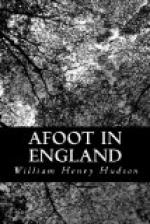The birds that lived on the huge cathedral itself had the greatest attraction for me; and here the daws, if not the most numerous, were the most noticeable, as they ever are on account of their conspicuousness in their black plumage, their loquacity and everlasting restlessness. Far up on the ledge from which the spire rises a kestrel had found a cosy corner in which to establish himself, and one day when I was there a number of daws took it on themselves to eject him: they gathered near and flew this way and that, and cawed and cawed in anger, and swooped at him, until he could stand their insults no longer, and, suddenly dashing out, he struck and buffeted them right and left and sent them screaming with fear in all directions. After this they left him in peace: they had forgotten that he was a hawk, and that even the gentle mousing wind-hover has a nobler spirit than any crow of them all.
On first coming to the cathedral I noticed a few pigeons sitting on the roof and ledges very high up, and, not seeing them well, I assumed that they were of the common or domestic kind. By and by one cooed, then another; and recognizing the stock-dove note I began to look carefully, and found that all the birds on the building—about thirty pairs—were of this species. It was a great surprise, for though we occasionally find a pair of stock-doves breeding on the ivied wall of some inhabited mansion in the country, it was a new thing to find a considerable colony of this shy woodland species established on a building in a town. They lived and bred there just as the common pigeon—the vari-coloured descendant of the blue rock—does on St. Paul’s, the Law Courts, and the British Museum in London. Only, unlike our metropolitan doves, both the domestic kind and the ringdove in the parks, the Salisbury doves though in the town are not of it. They come not down to mix with the currents of human life in the streets and open spaces; they fly away to the country to feed, and dwell on the cathedral above the houses and people just as sea-birds —kittiwake and guillemot and gannet—dwell on the ledges of some vast ocean-fronting cliff.




